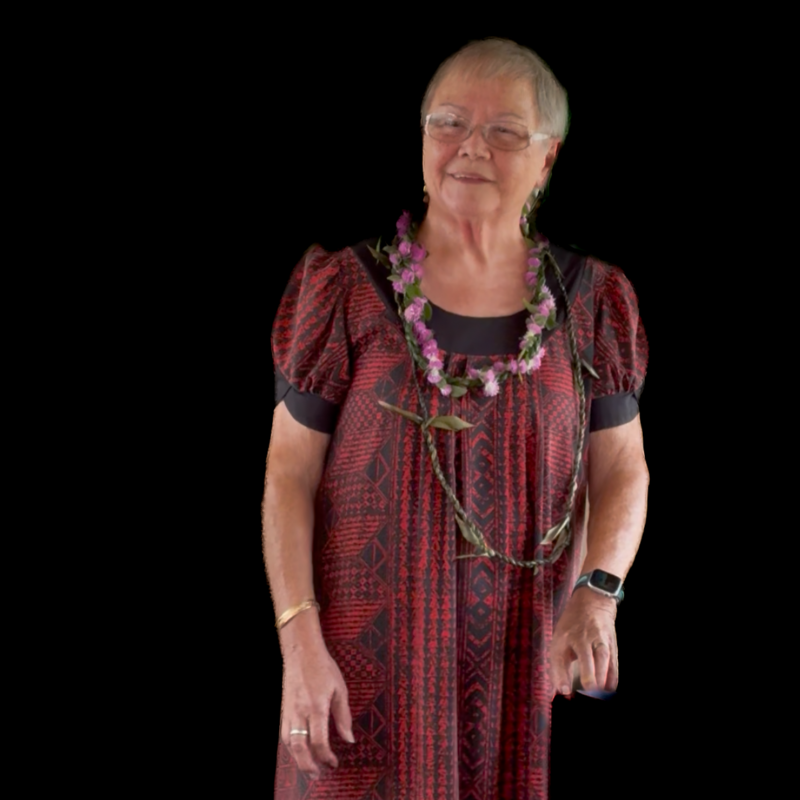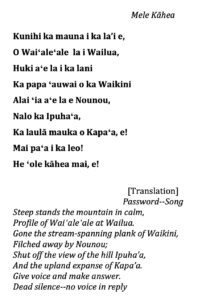Practicing Oli with Kumu ‘Ilima

On a beautiful sunny summer afternoon in July, members and guests gathered at the clubhouse to learn about the Hawaiian tradition of oli with Kumu Anita ‘Ilima Stern. Kumu ‘Ilima is a retired elementary school teacher who taught hula for 33 years. Some of you may remember her because she graced us with an opening and closing oli at the 2024 Holiday Luau.
When you first meet Kumu ‘Ilima, she emanates a sense of tranquility, grace and wisdom. However do not be fooled by her small stature and calm demeanor. To begin our oli lesson she stood tall and quietly looked around at the group, then she took a deep breath and chanted loudly in ʻŌlelo Hawaiʻi. Listening to her powerful voice chanting in the language of her ancestors was deeply moving, it was as if you could feel her channeling those who came before her.
We started our oli session with a brief overview of ʻŌlelo Hawaiʻi and pronunciation. Kumu ‘Ilima shared with us that her grandmother of Hawaiian ancestry grew up during the time when Hawaiians were not allowed to learn or speak the language. So in the 1970’s and 80’s her grandmother joined ‘Ilima and her sister when they took Hawaiian language classes. We learned that although there are only five vowels and eight consonants, due to the addition of diacritical marks the pronunciation can be more challenging. Kumu ‘Ilima referred to diacritical marks as consonants, as they can indicate a break in a word, a place to take a breath. It was only after reviewing and sharing examples of pronunciation that she began to teach us the oli.
Kumu ‘Ilima selected Oli Kāhea for us to learn because it is a chant that asks permission to enter a space or place (for a link to the oli and its mo’olelo CLICK HERE). Although she learned this protocol to enter a Hula Hālau, this oli can apply to asking respectfully to enter any space, including a trail. First Kumu ‘Ilima chanted the entire oli all the way through so that we could listen and record it (CLICK HERE for the video recording). Next she went through slowly line by line with us and we repeated after her. She patiently explained any pronunciation that we found particularly challenging. She had us chanting and repeating line by line slowly until eventually over the period of an hour we were able to string together the entire oli.
Along with explaining the mo’olelo (story) behind this oli*, Kumu ‘Ilima shared meanings and cultural traditions of the words and chanting. For example, after chanting the word “Wailua” she said she was taught to close her mouth if you don’t want anything bad to enter. She also reminded us that it is important after we perform the oli to wait, listen and observe until we notice a feeling in our gut that will tell us it is okay to enter before proceeding. More importantly if we get a feeling not to enter we must honor that and not enter the place.
Being in the presence of Kumu ‘Ilima and practicing this oli was a memorable experience. As a way to both honor and continue Hawaiian traditions she encouraged us all to share it with others. At the end of our session, Kumu ‘Ilima generously offered to arrange another session, so if anyone is interested in practicing this oli or would like to get in touch with ‘Ilima CLICK HERE. And if you attend HTMC’s 2026 Holiday Luau on December 6th, you will be blessed by the amazing experience of Kumu ‘Ilima’s powerful oli.
Oli Kāhea Moʻolelo
“This chant was taken from the story of Hiʻiaka, sister of Pele. She is journeying with the beautiful Hopoe to fetch prince Lohiau to the court of Pele. They have come by a steep and narrow path to the brink of the Wailua river, Kauaʻi, at this point spanned by a single plank. But the bridge is gone, removed by an ill-tempered moʻo said to have come from Kahiki, whose name, Wailua, is the same as that of the stream. Hiʻiaka calls out, demanding that the plank be restored to its place. Wailua does not recognize Hiʻiaka and makes no response. At this the goddess puts forth her strength, and Wailua, stripped of her power and reduced to her true station, that of a moʻo, a reptile, seeks refuge in the caverns beneath the river. Hiʻiaka betters the condition of the crossing by sowing it with stepping stones. The stones remain in evidence to this day.”
Source: Unwritten Literature of Hawaii: The Sacred Songs of the Hula by Nathaniel B. Emerson’s


